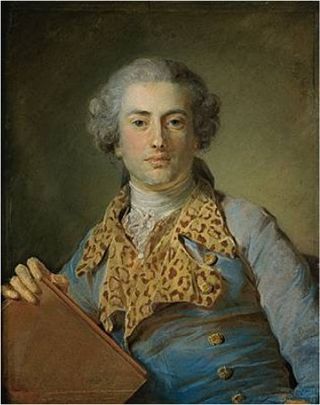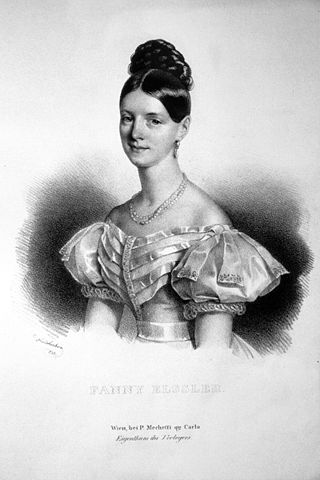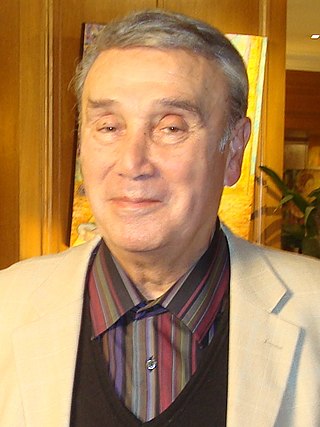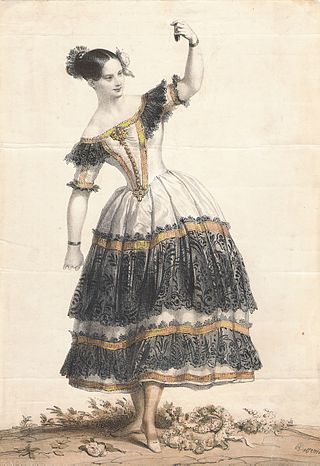
Cachucha is a Spanish solo dance in 3
4 or 3
8 time, similar to the bolero. Cachucha is danced to an Andalusian national song with castanet accompaniment.

Cachucha is a Spanish solo dance in 3
4 or 3
8 time, similar to the bolero. Cachucha is danced to an Andalusian national song with castanet accompaniment.
From Spanish cachucha, small boat. Possibly from diminutive of cacho, shard, saucepan, probably from vulgar Latin cacculus, alteration of Latin caccabus, pot, from Greek kakkabos, a small container.
The Cachucha was created in Cuba though it is now considered a Spanish dance. Fanny Elssler (1810-1884, Vienna) popularized this dance when she introduced it to the public in the ballet from Rossini's opera La donna del lago in 1830s London, and cemented its fame in Jean Coralli's ballet Le Diable boiteux (1836, Vienna).
Gilbert and Sullivan sets the dance for the entire company in Act 2 of the Savoy Opera The Gondoliers as the chorus sings Dance a Cachucha.

Gaetano Apolline Baldassarre Vestris, French ballet dancer, was born in Florence and made his debut at the opera in 1749.

Jean-Georges Noverre was a French dancer and ballet master, and is generally considered the creator of ballet d'action, a precursor of the narrative ballets of the 19th century. His birthday is now observed as International Dance Day.
A ballet company is a type of dance troupe which performs classical ballet, neoclassical ballet, and/or contemporary ballet in the European tradition, plus managerial and support staff. Most major ballet companies employ dancers on a year-round basis, except in the United States, where contracts for part of the year are the norm. A company generally has a home theatre where it stages the majority of its performances, but many companies also tour in their home country or internationally.

Marie Taglioni, Comtesse de Voisins was a Swedish-born ballet dancer of the Romantic ballet era partially of Italian descent, a central figure in the history of European dance. She spent most of her life in the Austrian Empire and France. She was one of the most celebrated ballerinas of the romantic ballet, which was cultivated primarily at Her Majesty's Theatre in London and at the Théâtre de l'Académie Royale de Musique of the Paris Opera Ballet. She is credited with being the first ballerina to truly dance en pointe.
Aschenbrödel (Cinderella) is a ballet written by Johann Strauss II. He had written all the principal parts of the ballet, and was intending to fill in the orchestration as time permitted. However, Strauss died in 1899, and it was finished by composer Josef Bayer in 1900.

Fanny Elssler was an Austrian ballerina of the Romantic Period.
Manela Bustamante was a famous Cuban actress, who performed the character Cachucha in perhaps the most remembered Cuban comedy show of its era “Cachucha y Ramón”. She later became a household name in Puerto Rico during the 70s as she became part of the cast in the show Los García.

Jean Coralli was a French ballet dancer and choreographer, best known for collaborating with Jules Perrot in creating Giselle (1841), the quintessential Romantic ballet of the nineteenth century.

Ballet is a formalized dance form with its origins in the Italian Renaissance courts of 15th and 16th centuries. Ballet spread from Italy to France with the help of Catherine de' Medici, where ballet developed even further under her aristocratic influence. An early example of Catherine's development of ballet is through 'Le Paradis d' Amour', a piece of work presented at the wedding of her daughter Marguerite de Valois to Henry of Navarre. Aristocratic money was responsible for the initial stages of development in 'court ballet', as it was royal money that dictated the ideas, literature and music used in ballets that were created to primarily entertain the aristocrats of the time. The first formal 'court ballet' ever recognized was staged in 1573, 'Ballet des Polonais'. In true form of royal entertainment, 'Ballet des Polonais' was commissioned by Catherine de' Medici to honor the Polish ambassadors who were visiting Paris upon the accession of Henry of Anjou to the throne of Poland. In 1581, Catherine de' Medici commissioned another court ballet, Ballet Comique de la Reine, however it was her compatriot, Balthasar de Beaujoyeulx, who organized the ballet. Catherine de' Medici and Balthasar de Beaujoyeulx were responsible for presenting the first court ballet ever to apply the principles of Baif's Academie, by integrating poetry, dance, music and set design to convey a unified dramatic storyline. Moreover, the early organization and development of 'court ballet' was funded by, influenced by and produced by the aristocrats of the time, fulfilling both their personal entertainment and political propaganda needs.

Ludwig Minkus, also known as Léon Fyodorovich Minkus, was an Austrian composer of ballet music, a violinist and teacher of music.

Jean-Louis Aumer, also referred to as Jean-Pierre Aumer, was a French ballet dancer and choreographer.
Andreas Hallager was a Danish musician, orchestra leader, and composer.

The Polish National Ballet is the largest and most influential ballet company in Poland. It continues a ballet heritage, dating to the 17th century.
Aurora de los Ángeles Bosch Fernández is a Cuban dancer and teacher of ballet. Along with Loipa Araújo, Josefina Méndez, and Mirta Plá, she is regarded as one of the "four jewels of Cuban ballet". She was a principal artist with the Cuban National Ballet.

The important place of women in dance can be traced back to the origins of civilization. Cave paintings, Egyptian frescos, Indian statuettes, ancient Greek and Roman art and records of court traditions in China and Japan all testify to the important role women played in ritual and religious dancing from the start. In the Middle Ages, what has become known as ballet had its beginnings in Italian court festivals when women frequently played the parts of men. It was however in late 17th-century France that the Paris Opera produced the first celebrated ballerinas. While women began to dominate the ballet scene in the 18th century, it was with the advent of Romantic ballet in the 19th century that they became the undisputed centre of attraction with stars playing the leading roles in the works of Marius Petipa, appearing in theatres across Europe from Milan's La Scala to the Mariinsky Theatre in Saint Petersburg. More recently, women have played a leading role in developing various forms of modern dance including flamenco and expressionist dance.

Bolero is a Spanish dance in 3/4 time popular in the late 18th and early 19th centuries. It originated from the seguidilla sometime between 1750 and 1772, and it became very popular in Madrid, La Mancha, Andalusia and Murcia in the 1780s. Bolero was performed as a solo or partner dance with a moderately slow tempo, accompanied by guitar and castanets, and with lyrics in the form of the seguidilla.

Pierre Lacotte was a French ballet dancer, choreographer, teacher, and company director. He specialised in the reconstruction of lost choreographies of romantic ballets.
Carolina Desideria Granberg also known as Carolina Friebel, was a Swedish ballerina. She was considered as one of the leading members of the Royal Swedish Ballet.

Don Chisciotte alle nozze di Gamace, composed by Antonio Salieri, is an Italian-language opera. The libretto presents the opera as in one act, and the musical score includes a mid-point division, both score, and libretto originally denoted the work a divertimento treatrale. The libretto was written by Giovanni Gastone Boccherini, dancer, poet and stage manager, brother of the composer Luigi Boccherini. The work is loosely adapted from chapters 19 and 21 of Part II of the novel Don Quixote by Miguel de Cervantes. The work was a hybrid opera buffa and ballet, with choreography by Jean-Georges Noverre.

Le Diable boiteux is a ballet in three acts by Jean Coralli, with music by Casimir Gide, which premiered on 1 June 1836 at the Paris Opera. The main roles were played by Fanny Elssler, Joseph Mazilier, Amélie Legallois, Pauline Leroux and Jean-Baptiste Barrez. Loosely inspired by the novel of the same name by Lesage, this ballet was the first great success of Coralli who had, until then, mainly re-edited the ballets of other authors. The cachucha performed by Fanny Elssler was a sensational success.